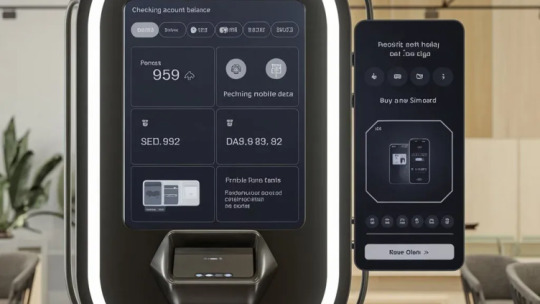#fasterchoice
Explore tagged Tumblr posts
Text

The Rise of Telecom Kiosks: Are They Replacing Traditional Phone Stores?
In today’s fast-paced digital landscape, self-service solutions are reshaping various industries, including telecom retail. Telecom kiosks are gaining traction as a convenient and cost-effective alternative to traditional phone stores. As major telecom brands embrace this innovation, the question arises: Will telecom kiosks replace traditional stores or will they complement them? Let’s explore the impact of this growing trend.
What Are Telecom Kiosks?
Telecom kiosks are self-service machines designed to handle a variety of customer needs, such as SIM card purchases, bill payments, mobile recharges, and customer support inquiries. Compact and equipped with interactive touchscreens, these kiosks eliminate the need for in-person assistance while ensuring quick and seamless transactions.
Factors Driving Their Popularity
Several factors contribute to the growing adoption of telecom kiosks:
Technological Advancements – AI-driven kiosks provide efficient customer service with minimal human intervention.
Convenience & Accessibility – Customers can complete transactions 24/7, reducing wait times and dependence on store hours.
Cost Savings for Telecom Companies – Kiosks reduce operational expenses related to staffing and rental space.
Changing Consumer Behavior – Modern customers prefer fast, contactless service options over traditional store visits.
Adoption by Major Telecom Brands
Leading telecom providers are integrating kiosks into their retail strategies. Companies like Verizon, AT&T, and Vodafone have deployed self-service kiosks in malls, airports, and retail centers to enhance customer convenience while optimizing their operational efficiency.
Comparing Telecom Kiosks and Traditional Phone Stores
Customer Experience: Kiosk vs. Store
Kiosks offer a fast, self-directed experience, ideal for simple tasks like recharges and bill payments.
Stores provide personalized support, making them preferable for complex queries like device troubleshooting or contract upgrades.
Pros of kiosks: Speed, availability, and convenience.
Cons of kiosks: Lack of human interaction, limited troubleshooting.
Cost Efficiency and Space Utilization
Kiosks require minimal space and staff, significantly reducing overhead costs.
Stores demand high rental and staffing expenses, making them more costly to operate.
Telecom brands can deploy multiple kiosks at a lower cost than opening a single new store.
Scalability and Expansion
Kiosks can be installed quickly and affordably in high-footfall areas.
Stores involve higher investment and require careful location planning.
The kiosk model enables brands to expand their reach without excessive financial strain.
Challenges and Limitations of Telecom Kiosks
Technical Issues and Downtime
Kiosks depend on software reliability; malfunctions can disrupt service.
Regular maintenance is required to prevent downtime and ensure customer satisfaction.
Limited Human Interaction
Customers who need assistance with complex issues may feel frustrated.
Some users, especially older generations, may prefer face-to-face support.
Restriction to Basic Services
Kiosks primarily handle routine transactions.
Services like in-depth technical support, device purchases and personalized consultations are still best handled in stores.
The Future of Telecom Retail
Integrated Retail Strategies
The future lies in a hybrid model, where kiosks enhance, rather than replace physical stores. Telecom brands may use kiosks to manage simple tasks, while in-store experts focus on more complex customer needs.
Innovations Enhancing Kiosk Capabilities
Emerging technologies will expand kiosk functionalities, including:
AI-powered virtual assistants for customer support.
Biometric authentication for enhanced security.
Expanded device dispensing for on-the-go mobile purchases.
Shifting Customer Expectations
As consumers embrace automation, telecom providers must balance efficiency with personalized service.
Younger generations prefer self-service, while older customers may still seek in-store interactions.
Conclusion
Telecom kiosks are transforming the industry by offering efficiency, accessibility, and cost savings. However, they are not a full replacement for traditional phone stores. Instead, telecom companies must adopt a blended approach, leveraging kiosks for routine tasks while maintaining stores for in-depth assistance. The future of telecom retail lies in a seamless mix of automation and human expertise—ensuring customers receive the best of both worlds.
Would you prefer a self-service telecom experience, or do you still value the in-store service? Share your thoughts in the comments!
#telecomkiosk#SIMkiosks#dispensingmachines#kiosktechnology#fasterchoice#smarteroption#innovativekiosks#convenientdispensing#streamlinedprocess#efficiencyboost#futureofdispensing#simdispensingkiosk#kiosk#kioskmachine#selfservicekiosk#telecomcompanies#uae#saudiarabia
0 notes